The snout is known for its extra long snout which is obvious. The habitat is open woodlands and streams with hackberries and thickets. These are much more common to the south especially in the coastal plain than in the mountains where they are uncommon. American Snouts do over winter as adults and can be found on warm days in the winter in the southern portion of the region.
 |
Wingspan: 2 1/2 - 4 1/2 inches. Flight: Mid March until mid October |
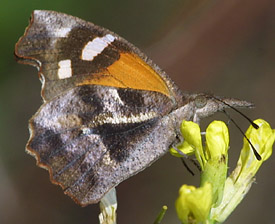
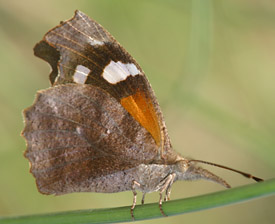
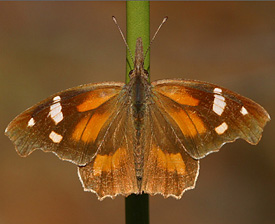
The Gulf Fritillary is a southern migrant that works its way northward up the coast and northwestward towards Asheville NC. These can be found in large numbers during peak years. Usually these become common in the southern coastal plain in late summer and fall.
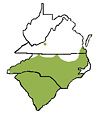 |
Wingspan: 2 - 2 1/2 inches Flight: May until mid December |
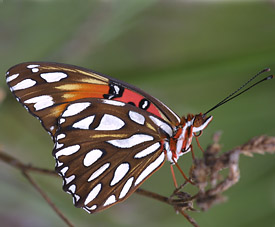
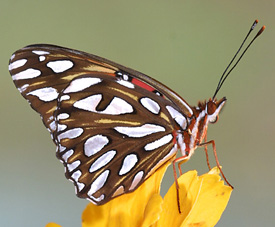
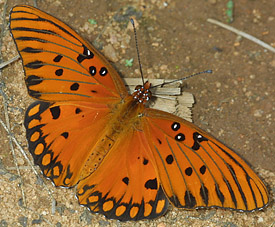
The region's most widespread fritillary it can be found in most open fields, meadows and gardens. Tends to be very common in the coastal plain and piedmont and uncommon in the mountains. In flight it can be mistaken for the American Lady. The female Tawny Emperor looks a lot like it except, for the pale antenna tips.
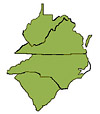 |
Wingspan: 1 3/4 - 2 1/2 inches Flight: Mid April until December |
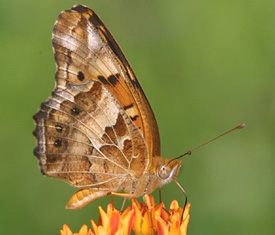
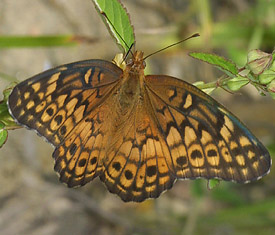
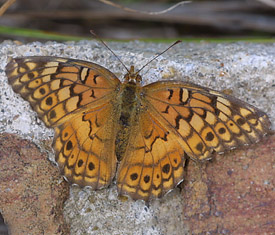
This large fritillary is the most common of the larger fritillaries. It can be found in meadows, pastures and gardens. An easy field mark on the hindwing is the light orange band between the "spangled" white spots. The other mountain species that might confuse you are the Aphrodite Fritillary and rarely in higher elevations in the Virginias and further north the Atlantis Fritillary.
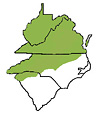 |
Wingspan:
2 1/8 - 3 inches Flight: Mid May until mid October |
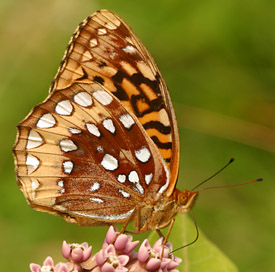
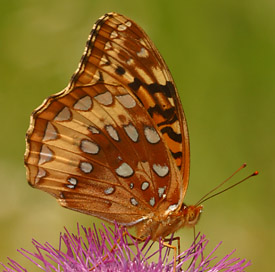
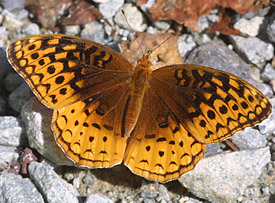
From above, most of the larger fritillaries appear nearly identical. It is best to get an underside look to get a good ID.
This is the region's smallest fritillary and it tends to fly close to the ground. The habitat is meadows, weedy fields, pastures and roadsides in the mountains mainly. The only species that might be confused with it is the very rare Silver-bordered Fritillary which likes very tall grassy meadows and occurs from the Virginias northward.
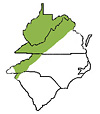 |
Wingspan:
1 1/4 - 1 7/8 inches Flight: April until mid October |
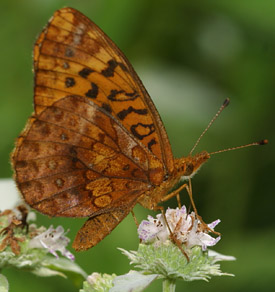
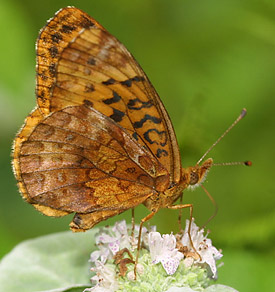
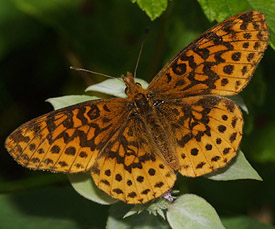
This species is slightly larger than the more common Pearl Crescent (the next species below). Telling these two apart takes a little practice as both can be found in the same habitat which is wet woodlands, gardens, roadsides and adjacent damp areas. Silvery Checkerspot is more common in the mountains than the piedmont. In West Virginia the Harris' Checkerspot adds to the confusion; a quick look at the underside is the best way to tell the two apart.
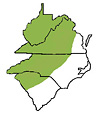 |
Wingspan: 1 3/8 - 1 7/8 inches Flight: May until early September |
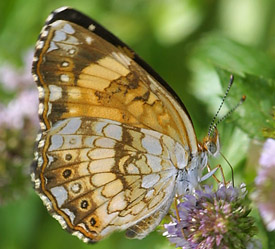
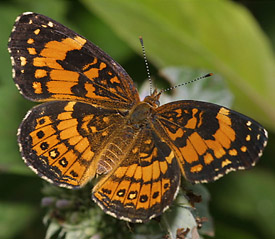
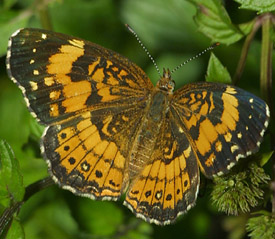
One of the most variable and wide spread butterflies in the region. It can be found almost anywhere including lawns, woodland edges, roadsides, power line cuts and adjacent open areas. Depending on where you are and what time of the year it is, there are a few species that could confuse you, but most you see would likely be Pearl Crescents. Along the southern coast the tiny Phaon Crescent is the only similar species.
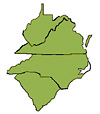 |
Wingspan: 1 - 1 1/2 inches Flight: Mid March until late November |
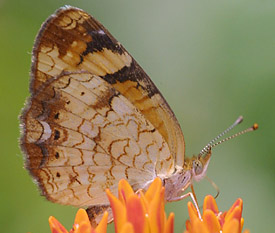
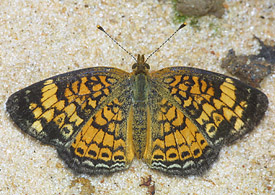
Female "summer form" Pearl Crescent
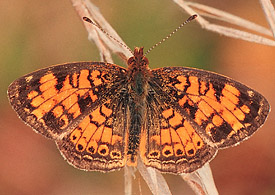
Male "spring form" Pearl Crescent
Named for the "?" mark in the center of the hindwing. Telling these apart from the Eastern Comma (next species below) can be challenging. Look for the two part "?" below, the four black spots in a row across the center of the forewing and the much more pointed angular wings. These are rapid fliers and sometimes they don't land for identification; these are just called anglewing species. Question Marks do over winter as adults and can be found on warm days during winter.
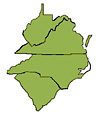 |
Wingspan: 2 3/8 - 2 5/8 inches Flight: All year, even warm spells in winter. Absent during the heat of summer. |
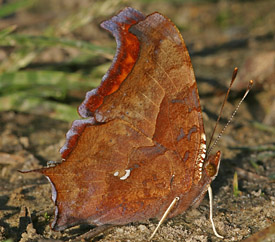
The underside can be quite variable
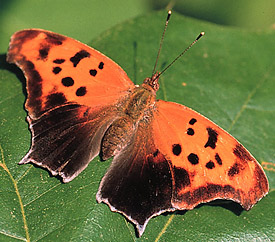
Spring (black) form
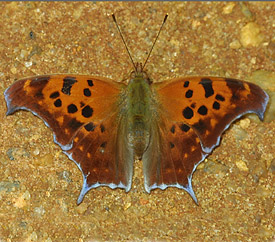
Fall (orange) form
Named for the comma on the hindwing. Telling these apart from the Question Mark (species above) can be challenging. Look for the comma-shaped mark on the underside, the three black spots across the center of the hindwing and the more bluntly shaped wings. In the mountains at very high elevations the very rare Green Comma and Gray Comma might be mistaken for Eastern Comma from above. Eastern Commas do over winter as adults and can be found on warm days during winter.
 |
Wingspan: 1 3/4 - 2 inches Flight: All year, even warm spells in winter. Absent during the heat of summer. |
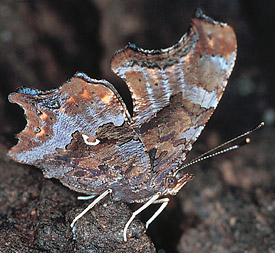
The underside can be quite variable
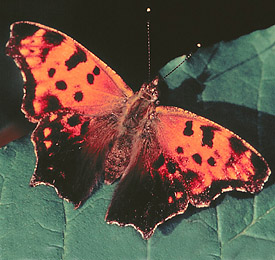
Summer (black) form

Fall (orange) form
They tend to hilltop along roadsides paths and openings in the forest. As you can see, identification is very easy.You can find them in late winter or early spring as they overwinter as adults. During the heat of the summer they aestivate and when it becomes cooler you can find them again.
 |
Wingspan:
2 - 2 3/8 inches Flight: All year, even warm spells in winter. |
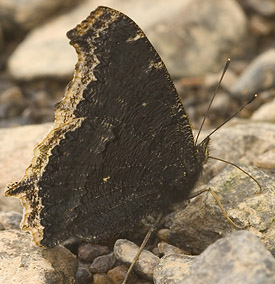
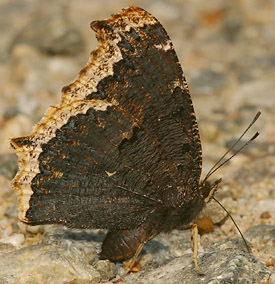
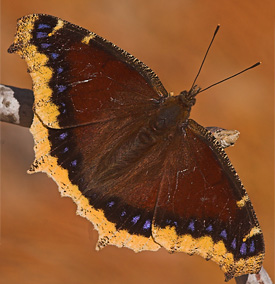
Very common throughout the entire region in fields, meadows, roadsides and gardens during the entire butterfly season. On the underside of the hindwing, there are two eye-spots; the lower one is slightly larger than the other. The similar Painted Lady has four smaller eye-spots and occurs less frequently than the American Lady.
 |
Wingspan: 1 3/4 - 2 1/8 inches Flight: Mid March until November |
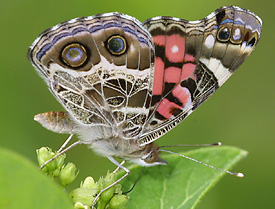
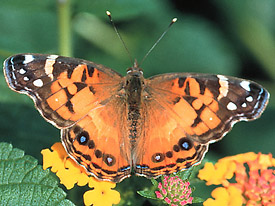
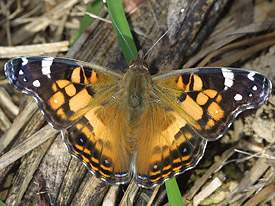
This butterfly is found even in Europe and Asia; they migrate in large numbers some years. I found a large number of them in the WV mountains several years ago. They tend to hilltop and will usually attack whoever walks by their territory. During mild winters they can over winter.
 |
Wingspan: 1 3/4 - 2 1/4 inches Flight: Early April until early November |
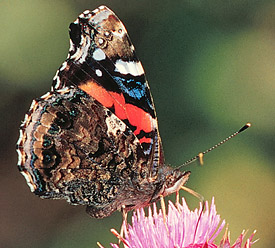
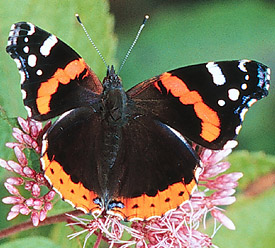
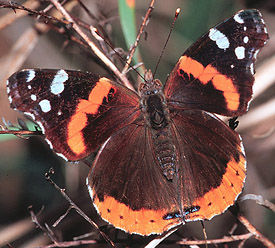
Common
Butterflies Page #05
Go to Brush-footed Butterflies Part 2
Go to Brush-footed Butterflies Part 2